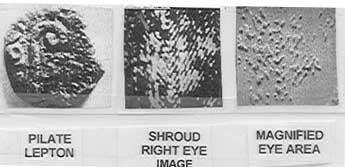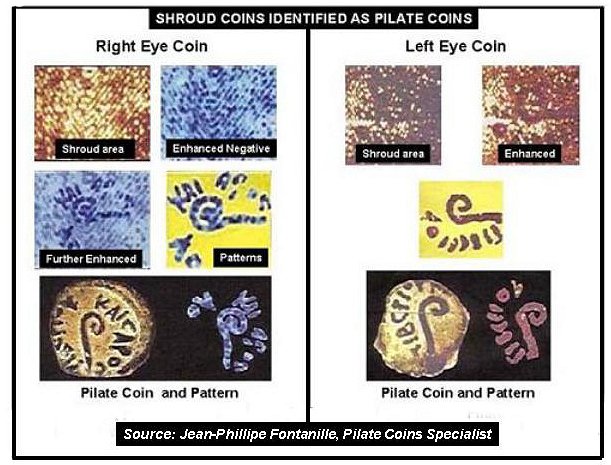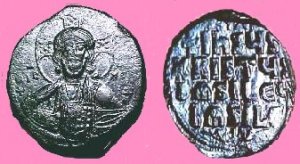The two suspected coins placed on the eyes are believed to be Pilate coins, small bronze coins issued AD 30 or 31. Earlier attempts to identify the right eye coin seemed to reveal the letters UCAI and a lituus (the auger wand with a top end like a shepherd's crook) at the center. All available Pilate coins with the lituus show the name of the Roman emperor at the time, Tiberius Caesar in Greek letters, TIBEPIOY KAICAPOC where the C, P and Y should sound like our S,R, and U respectively. It was thought that UCAI is an altered or even a mis-spelled form of Y KAI. A coin in the collection of Fr. Filas in Layola University in Chicago seemed to show the same letters. Later on, the coin on the left eye was conjectured to be a Julia coin (also issued by Pilate) with a simpulum (like a ladle) at the center. See pictures of these earlier identification below  Canadian numismatist Jean-Philippe Fontanille questions the above identification of the letters, and the identification of the left eye coin. He points out that the C letter is never found used in place of K in all the known Pilate coins. By enhancing the coin areas he has shown that both eyes were covered by similar Pilate coins; the right eye coin had the letters OY KAI APOC of the full name TIBEPIOY KAICAPOC (note the spacing between Y and K; the space between I and A should have the letter C which is missing) ; the left eye coin shows the letters TIBEPIOY. The obverse of the Pilate coins usually have the date indicator LIZ or LIH corresponding to the year 30 and 31 of the Christian era(LIZ and LIH mean Year 17 and Year18 respectively, from the accession of Tiberius Caesar). However, this side cannot be seen on the image. Two possible dates for the Crucifixion are April 6, AD 30 and April 1, AD 33 The LIZ coin may have been in circulation in April 30, and was definitely available in April 33. The LIH dated coin would also be available in AD 33. An interesting bit of information that may be added is that the birth of Christ is also given two possible dates: Sep 11, BC 3 (according to Dr. Earnest Martin) and Sep 27 BC 2 (according to Dr. Jerome Johnson). The latter date gives exactly 33½ years for the life of Christ and may be the more reliable dating . For more details on these dates, read 'The Star of Bethlehem' by Martin (ASK Publications), and 'At The Right Time' by Johnson (Bathkol Books, 1998). The following picture collage is based on images extracted from the Shroud eye area image by Jean-Philippe Fontanille in Montral, Canada and sent to the author. In his book, ‘The Coins of Pontius Pilate’ (Shangri La Publications, July 2001), Jean-Philippe has identified the right eye coin as in the collage, but the left eye coin was not clearly identified, though an attempt was made to identify the AD 29 Pilate coin known as Julia lepton with three barleys and a simpulum as claimed by Dr.Alan Whanger who had used his polarized overlay technique (see pp. 92-96 of the above book). His later identification of the left eye coin as shown in the collage, not in his book, indicates that it is a Pilate lepton with a lituus similar to the one on the right eye.  |
